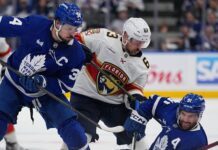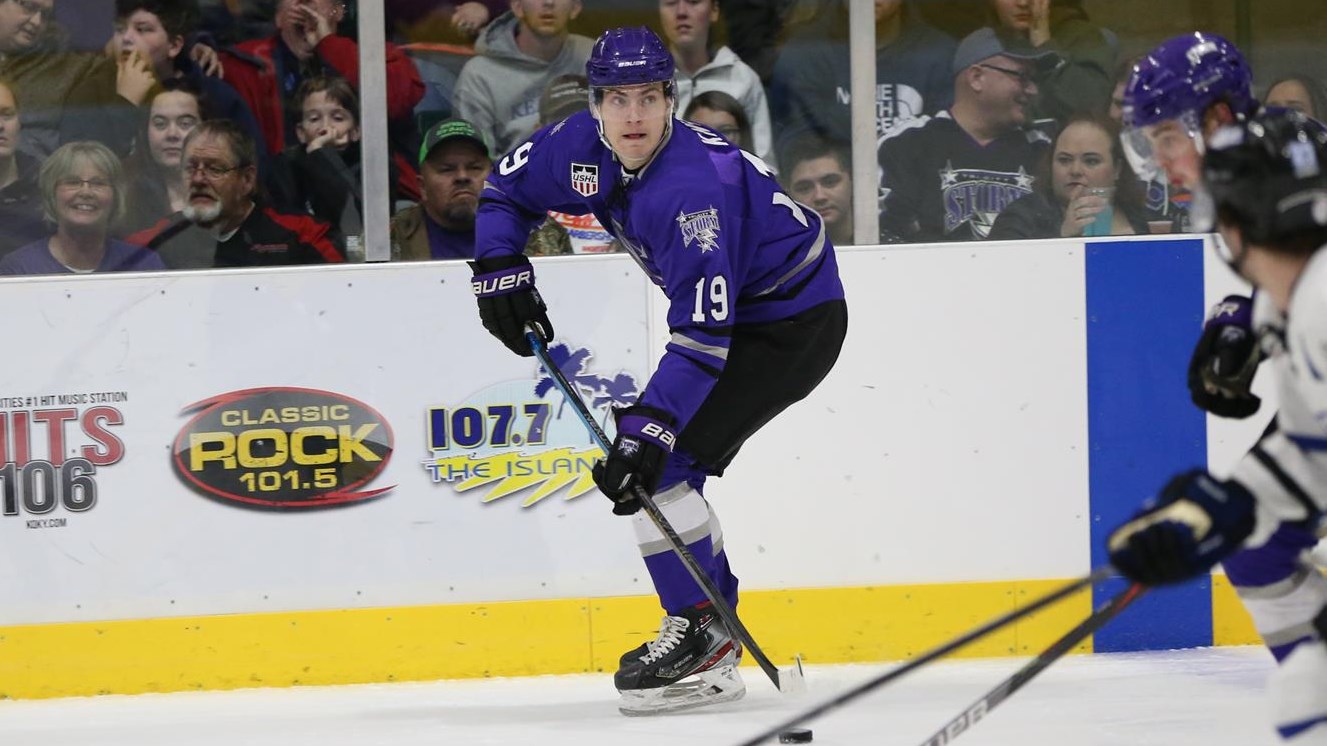With the 57th overall selection in the 2021 NHL Draft, the Toronto Maple Leafs have selected 6’3, 210-pound left winger Matthew Knies of the USHL’s Tri-City Storm.
The tallest Leaf skater selection since 2017 (when the Leafs picked towering defensemen Eemeli Rasanen and Fedor Gordeev) and tallest forward selection since Egor Korshkov in 2016, Knies is a player who the Leafs‘ new Senior Director of Minor League Operations, Ryan Hardy, would be quite familiar with due to his USHL background as the former GM of the Chicago Steel.
The Leafs also used to employ Ryan Ward — who worked for the Marlies and Leafs as a video coach from 2014-2016 — and he is a connection they likely tapped into for video work and intel on Knies, with Ward now serving as the Director of Player Development for the Tri-City Storm. In a year where sufficient viewings and complete information on draft prospects is a major challenge, the Leafs would have had a really thorough background on this player from the past few years, including this most recent season.
Described as a dynamic power forward, the Arizona-born Knies has been about a point-a-game scorer in the USHL for Tri-City for the past two seasons. Despite some game postponements and cancellations, it was fairly close to a full schedule of games for the USHL amid the Covid pandemic (54 games for most teams vs. 62 in a normal year). Knies finished 26th in the league in points per game with 42 points in 44 games as an 18-year-old (14th among 18-and-under players) this past season after a slow start with just eight points in 16 games — a first half that was impacted by Knies contracting Covid.
One of the older first-year draft eligibles with an October 2002 birthdate, Knies is described by the 2021 Blackbook as playing, “a technical, hybrid power forward game… one of the rarest players you can find, in the sense that he can beat the first layer with his speed, frame, and range. He can then beat the second layer with his exceptional hands, and beat the third layer by using his deception and dual-threat attributes. He has it all, but it took him time.”
Obvious in their description of the player above, the Blackbook was the highest on Knies of any major scouting publication, ranking him as the 13th-best prospect in the 2021 draft. Here were Knies’ other pre-draft rankings:
- Ranked #66 by ELITEPROSPECTS.COM
- Ranked #62 by TSN/BOB McKENZIE
- Ranked #81 by MCKEEN’S HOCKEY
- Ranked #43 by TSN/CRAIG BUTTON
- Ranked #37 by NHL CENTRAL SCOUTING (NA Skaters)
- Ranked #62 by DOBBERPROSPECTS
Matthew Knies to Toronto: He has all the tools to be a very good power forward at the NHL level. The skating got better, he has great hands, great shot, and playmaking abilities. He's one of the best players to protect the puck in this draft. One of our favourites #NHLdraft
— Jérôme Bérubé (@Jerome_Berube) July 24, 2021
Knies is committed to the University of Minnesota for 2021-22.
Matthew Knies Scouting Report
courtesy of the 2021 Blackbook (buy now)
Knies is a dynamic power forward with one of the most extensive tool kits out of any draft-eligible player featured in this class. He had a tough start to the year, recording only eight points and two goals in his first 16 games. Even when he wasn’t producing at the start of the season, though, he was still flashing his talent, but he wasn’t honing his skillset to take full advantage of his physical base. Fast forward to mid-March, after the power began to develop within his skating base and he started recognizing how to put it all together, he didn’t look back, becoming one of the most dominant players who had one of the best development arcs in the 2021 draft. In his final 15 games, he recorded 24 points, including 12 goals. That’s the type of curve you’re always looking for.
Matthew has one of the largest array of skills you can have as a prospect. On the one hand, that’s a phenomenal quality. On the other hand, it might lead to a prospect like Matthew having difficulty figuring out where he should use each one of his skills out on the ice. There was a lot of experimentation from him, and that’s not unexpected. It reminded us of Matt Boldy, who is more talented than Knies but was also in an experimental phase because of the sheer number of skills he possessed in combination with his frame. That’s the real determining feature when evaluating a really talented power forward like Knies. The main criteria that we break down when we want to see translatable qualities is how a bigger-framed kid can blend his skillset while using his frame to create disadvantages for the defense.
What makes Knies an A-rated prospect for us is that he can blend his frame, on top of his skillset, with an exceptional level of deception. The moniker or term “power forward” still has the original association of barreling down a wing, but that’s how Knies usually operates. He’s not a Vasili Podkolzin or Josh Anderson type of power forward. Don’t get us wrong, we absolutely respect and appreciate the original style of power forwards, but we also have a ton of time for the technical, hybrid power forward game that Knies is developing. When he’s on the rush, he’s not looking to just blow by his opponents all the time, although, towards the end of the season, he was doing that in spurts, too. Often, he was suddenly switching his tempo, making exaggerated spinning postural moves, while simultaneously looking off his teammates before threading well-executed passes through layered traffic, after drawing in multiple opponents, as an example. He’s one of the rarest players you can find in the sense that he can beat the first layer with his speed, frame, and range. He can then beat the second layer with his exceptional hands and beat the third layer by using his deception and dual-threat attributes. He has it all, but it took him time.
It’s incredibly hard to pick just one or two skills that bring it all together. For us, it’s how he sets up plays with his advanced look-offs and how he can use his frame in combination with his playmaking by making half-rotations or full-spinning plays. As an example, he can spin off pressure, then explode and take a direct route to the net. Just as he’s cutting, he slips a clean, no-look pass into the slot that goes undetected because of the speed that he makes the pass. He can use his length better than most other forwards in this class by hooking and pulling passes around sticks as well. It doesn’t hurt that he’s an exceptional skill chainer. When you bring his coordination and dexterity into play with his frame, it’s a severe undertaking for a defender to deal with him.
We always stress finding prospects who are built for the playoffs. There are very few prospects that can theoretically drain the energy out of defensemen around the goal line and net area like Knies can at the NHL level. He just has so many different options to protect the puck and force opponents to double-team him, which creates space. When pressured, he has a lot of poise and remains calm in the pocket, finding available options with his vision or relying on his exceptional processing in tight spaces to protect the puck with his hands. He’s a space-creating machine in the making and it makes him such a well-rounded player. He can be a line driver who can set up snipers, a complimentary piece who finishes off the passing plays, or the player on a line who goes to the dirty areas and creates havoc down low around the net area. The versatility is basically unmatched when comparing him to other forwards featured in the A-range.
When he does have space, he’s incredibly dangerous with the puck. Again, he’s a talented playmaker, but he can score in a ton of different ways. That said, this wasn’t always the case. To Knies’s credit, he had to make some adjustments. His shooting mechanics were never the problem, even stemming back to last season. We evaluated him as a dual-threat who can score down the road. However, for the first third of the season — and this applies to last season as well — he had difficulty assessing when and where he should shoot.
As mentioned earlier, though, once he put it all together, we started seeing Knies grow in confidence with his shot quality and beat goalies in a multitude of ways. His goals range includes drive-by redirections, in tight pulling backhanders, soft catch and release wrist shots off of lateral passes, top-shelf wrist shots while in motion after driving down the high slot, and rebounds. He can score in tight, he can score from range, and he needs very little time to get set into his release. He has a big frame and he uses his frame in combination with his dexterity so that he can drop through his shot, while activating his bottom hand. Most of his extensions within his shot explode upwards in an arch, which indicates real strong bottom-hand activation within his wrists. He’s an explosive shooter and we think he will score more in the NHL than we have seen in his junior career.
I’m sure some of you are wondering about his defensive play, when we’ve been talking about how many different offensive tools that he has available to use. It’s a good question, and our answer is that he’s capable of taking control of the play on both sides of the puck. He can drive possession with the puck, but he can dictate defensive play when he’s using his frame and effort level correctly to apply pressure to players. His length and understanding of how to get underneath players is high-end. He can generate a lot of takeaways and also draw a lot of penalties. Matthew is a big and powerful kid. Over the course of the season, you could see that he was starting to learn how to take advantage of his leverages so that he could overwhelm smaller players.
Most of you can probably tell by now that we are big believers in Knies. That said, there are still some drawbacks. For one, although he improved his stride, there are still some mechanical inconsistencies. He can slouch over at times, and he’s not the most agile skater. We mentioned that he can pivot and turn and slip off of coverage, but he doesn’t have the best edge work. He’s also not very agile, and that’s got him in trouble when his hands fail him in one-on-one situations or when he’s trying to break through defensive layers.
Additionally, although we would grade his hockey sense as good, there are still some mental glitches in how he operates occasionally. For example, he can sometimes fail to anticipate the forecheck properly or fail to recognize when he needs to support along the wall as fast as needs to. He can fail to recognize how quickly he needs to get inside positioning off of a give-and-go sequence to receive a pass in a high-danger area. Lastly, he’s still in the developmental stages of learning how to react to resistance with his frame. That said, we think the agility will improve and we think he will learn how to use his frame even better than he already does. His mental game is mostly consistent.
Power forwards generally take a longer time to develop their skill set so that they can become consistent. Power forwards that have a remarkable range of skills while still growing into their bodies can take even longer. This is why we believe Knies is just starting to untap his true offensive potential. He was sort of in experimental mode up until the latter portion of the season, and once he put it all together, he became absolutely dominant on both sides of the puck.
You can’t find prospects with Knies skillset too often, and when you factor in his development curve, we’re all in. His pace, secondary effort, battle level, and willingness to play a heavy game just add that extra component that’s needed in order for his floor to be that of a third-liner, or so we think. Knies has the potential to be a legitimate top-six power forward that brings unreal versatility, though. We think that’s the more likely outcome, which is reflected in our rankings.
GM Kyle Dubas on Matthew Knies
Our scouting staff, led by John Lilley, has been very high on Matthew for some time. We especially like the way he finished his year in Tri-City in the USHL and the way that he played in the playoffs against Fargo for them. They have done a lot of work on him over the last several years. We will continue to watch him develop with the staff at the University of Minnesota.
The games I had watched happened after our season had ended and they were more late in the season watching the USHL in the playoffs with greater interest. In the games I watched, he played very, very well.
John can probably talk about what he saw early in the year, but for me in this position, it is always great to see someone who struggles, comes through it, emerges, and has that ability to do so. That’s what we saw from Matthew this year.
Obviously, there was a lot of expectation coming in. The first half didn’t go the way that he wanted it to in terms of offense. In the second half, he came out flying and was solid for Tri-City in their playoff series against Fargo.
That is a very strong sign for us in terms of the fact that he is going to go into college next year in a great program in Minnesota. It is not going to be easy. He has now shown he can overcome those challenges and assert himself — and his style of play — even if things don’t go right for him right off of the bat.
Director of Amateur Scouting John Lilley on Matthew Knies
Left wing. Left shot. Powerful skater. Good offensive player. He had two good seasons in the USHL. Headed to the University of Minnesota. Very pleased with this selection.
Matthew is a really good player. We really valued his game as an underager in the USHL. He had a real strong season. I wouldn’t say he struggled, but he didn’t have the first half people anticipated. He bounced back and had a really good second half. He really showed what he was capable of.
He played really good hockey — playoff hockey. He was productive. He played hard on a consistent basis. He played 200 feet. He really rounded out his game. He had a great underage season, and not unlike a lot of players who come into their draft year… I don’t know why he had a bit of a struggle to start, but a lot of players put a lot of pressure on themselves because of the draft or different things.
I just thought he rounded out his game, overcame the adversity, and just played really well down the stretch: fast, aggressive, and productive. He did everything we expected him to do coming into the season, but it took him a little longer than I am sure he wanted.
Our scouts in the U.S., Scott Bell and Tony Martino, really liked this kid for two years. Obviously, Ryan coming aboard was an added bonus. Ryan knows the league inside and out as the GM of Chicago. It was a staff decision — Tim Speltz as well, and we all watched Matthew for two years.
For us, with where we got him, we were extremely excited and a little bit surprised he was there. We think he has a lot to his game. He is a talented kid. He is big, strong. He has skill and a good shot. Good offensive instincts. We are really excited.
He is going to the University of Minnesota. Obviously, it’s Big 10 and a great program. We are excited for his development and to see where he can be in a few years.
Matthew Knies on his season
The first half of the season was a little chaotic for me. I got Covid. Our game started to get canceled. I couldn’t get into a rhythm or start clicking with some players. Once the second half came around and none of our games were getting canceled, I was able to start picking up. That was when my game kind of took off and our team did as well. We had a strong push in the playoffs, with obviously a disappointing loss. I tried to bury my head and work harder, focus on the players around me and making them better players and people. It was a chaotic season, but I think I developed a lot and was able to mature as a leader and person as well.















![John Gruden after the Leafs prospects’ 4-1 win over Montreal: “[Vyacheslav Peksa] looked really comfortable in the net… We wouldn’t have won without him” John Gruden, head coach of the Toronto Marlies](https://mapleleafshotstove.com/wp-content/uploads/2025/09/gruden-post-game-sep-14-218x150.jpg)


















